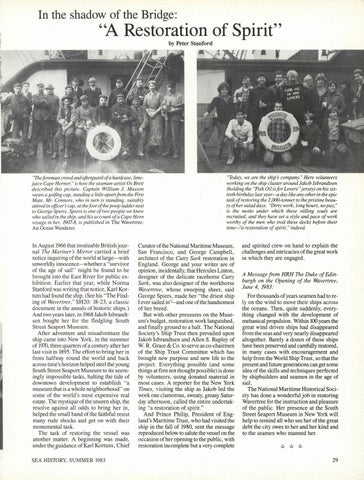In the shadow of the Bridge:
''A Restoration of Spirit'' by Peter Stanford
"The foremast crowd and afterguard ofa hardcase, limejuice Cape Horner," is how the seaman-artist Os Brett described this picture. Captain William J. Masson wears a golfing cap, standing a little apart from the First Mate, Mr. Connors, who in turn is standing, suitably attired in officer's cap, at the foot ofthe poop lmlder next to George Spiers. Spiers is one of two people we knew who sailed in the ship, and his account ofa Cape Horn voyage in her, 1907-8, is published in The Wavertree: An Ocean Wanderer. In August 1966 that invaluable British journal The Mariner's Mirror carried a brief notice inquiring of the world at large-with unworldly innocence-whether a "survivor of the age of sail" might be found to be brought into the East River for public exhibition. Earlier that year, while Norma Stanford was writing that notice, Karl Kortum had found the ship. (See his "The Finding of Uiivertree," SH20: 18-23, a classic document in the annals of historic ships.) And two years later, in 1968 Jakob Isbrandtsen bought her for the fledgling South Street Seaport Museum. After adventure and misadventure the ship came into New York, in the summer of 1970, three quarters of a century after her last visit in 1895. The effort to bring her in from halfway round the world and back across time's horizon helped steel the young South Street Seaport Museum to its seemingly impossible tasks, halting the tide of downtown development to establish "a museum that is a whole neighborhood" on some of the world's most expensive real estate. The mystique of the unseen ship, the resolve against all odds to bring her in , helped the small band of the faithful resist many rude shocks and get on with their monumental task. The task of restoring the vessel was another matter. A beginning was made, under the guidance of Karl Kortum , Chief SEA HISTORY, SUMMER 1983
"Today, we are the ship's company." Here volunteers working on the ship cluster around Jakob /sbrandtsen (holding the "Fish Oil is for Lovers "jersey) on his sixtieth birthday last year-a day like any other in the epic task of restoring the 2 ,000-tonner Jo the pristine beauty ofher salad days. "Dirty work, long hours, no pay," is the motto under which these willing souls are recruited, and they have set a style and pace of work worthy of the men who trod these decks before their time-"a restoration of spirit," indeed.
Curator of the National Maritime Museum, San Francisco, and George Campbell, architect of the Cutty Sark restoration in England. George and your writer are of opinion , incidentally, that Hercules Linton, designer of the delicate racehorse Cutty Sark , was also designer of the workhorse Wavertree , whose sweeping sheer, said George Spiers, made her "the driest ship I ever sailed in'!.._and one of the handsomest of her breed . But with other pressures on the Museum's budget, restoration work languished, and finally ground to a halt. The National Society's Ship Trust then prevailed upon Jakob Isbrandtsen and Allen S. Rupley of W. R. Grace & Co. to serve as co-chairmen of the Ship Trust Committee which has brought new purpose and new life to the project. Everything possible (and some things at first not thought possible) is done by volunteers, using donated material in most cases. A reporter for the New York Times, visiting the ship as Jakob led the work one clamorous, sweaty, greasy Saturday afternoon, called the entire undertaking "a restoration of spirit." And Prince Philip, President of England's Maritime Trust, who had visited the ship in the fall of 1980, sent the message reproduced below to salute the vessel on the occasion of her opening to the public, with restoration incomplete but a very complete
and spirited crew on hand to explain the challenges and intricacies of the great work in which they are engaged . A Message from HRH The Duke of F,dinburgh on the Opening of the Uiivenree, June 4, 1983:
For thousands of years seamen had to re-
1y on the wind to move their ships across the oceans. Then, quite suddenly, everything changed with the development of mehanical propulsion. Within 100 years the great wind driven ships had disappeared from the seas and very nearly disappeared altogether. Barely a dozen of these ships have been preserved and carefully restored, in many cases with encouragement and help from the World Ship Trust, so that the present and future generations can get some idea of the skills and techniques perfected by shipbuilders and seamen in the age of sail. The National Maritime Historical Society has done a wonderful job in restoring Wavertree for the instruction and pleasure of the public. Her presence at the South Street Seaport Museum in New York will help to remind all who see her of the great debt the city owes to her and her kind and to the seamen who manned her.
29
